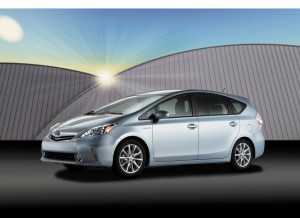
Prius v station wagon uses the same platform, hybrid technology and nickel metal hydride battery pack as the current Prius. Main benefits are 34 cubic feet of cargo space, and projected EPA fuel economy ratings of 40 mpg combined – the best of any mid-size crossover or SUV on sale in the U.S.
Toyota Motor Sales unveiled a Prius family of vehicles today, as part of corporate plan for adding 11 new hybrid models to its global lineup in the next 23 months.
For the automaker, the hybrid rollout cannot happen too soon. U.S. sales in 2010 were flat as all other major makers posted increases during a modest market recovery. For recall-ridden Toyota it was the worst year since it came to the U.S. 55 years ago.
Seven of the new hybrids – including plug-ins with lithium ion batteries – will be entirely new, not the next versions of existing models.
The gasoline powered Prius vehicles shown today all look likely to offer the highest EPA fuel economy ratings for vehicles that don’t plug in that is. The Environmental Protection Agency has just come up with a convoluted formula for plug-in hybrids and electric vehicles that allow for almost 100 mpg claims.
The current five-passenger Prius at 50 mpg remains the fuel economy leader as gasoline prices head above $3 a gallon, again, with some saying $4 is likely this year. My test drives of Prius models indicate that 50 mpg is indeed obtainable. I am skeptical of EPA ratings for the Nissan Leaf and the Chevrolet Volt hybrid based on limited test drives.
Company head Akio Toyoda said from a stage in Cobo Hall that the introduction was the next “major step” for what is the world’s most famous and without question best selling hybrid, the Prius mid-size hatchback. This third generation Prius, introduced two years ago will be joined in the late summer of 2011 by the mid-size Prius v station wagon, which uses the same platform, hybrid technology and nickel metal hydride battery pack as the current Prius. Its primary benefits are 34 cubic feet of rear cargo space, and projected EPA fuel economy ratings of 42 mpg city, 38 highway, 40 combined – the best of any mid-size crossover or SUV on sale in the U.S. at the moment.
“The Prius v is an all-new dedicated hybrid vehicle, and all future Prius family members will be as well,” said Bob Carter, Toyota Division group vice president and general manager.
Further away are the introductions of a Prius Plug-in version of the hatchback, and the Prius c, both during the first half of 2012.
Depending on conditions, Prius Plug-in can be driven about 13 miles on battery power at speeds up to 60 mph. Its compact lithium-ion battery provides less weight and a quicker recharging time, taking three hours on 110 volts and 1.7 hours on 220 volts. It can be “topped off” anytime with a convenient short charge, according to Toyota.
The Prius c Concept is a small, sub-compact city car that Toyota says is aimed at young singles and couples. It will be the least expensive hybrid in the Prius line, with the highest mileage of any “plug-less” hybrid available in the U.S., according to Toyota.
The Toyota Prius mid-size hatchback has accounted for more than 955,000 sales in the U.S. since it was introduced in 2000. The third-generation Prius, which reached dealerships in June 2009, has continued the hybrid’s sales leadership with great fuel economy and low emissions, while becoming the third-best selling Toyota passenger car in the U.S. following Camry and Corolla.
A Consumer Reports survey just released said Toyota lost “significant ground to Ford in consumer regard over the last two years.” This comes from the Consumer Reports’ 2011 Car Brand Perception Survey. “Now, the two brands rank a close first and second in overall perception, with Ford having a clear advantage in the factors that matter most to car shoppers: Safety, quality, and value,” according to CR.
The new Prius models can’t come soon enough to help Toyota dig its way out of its current sales slump.

